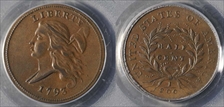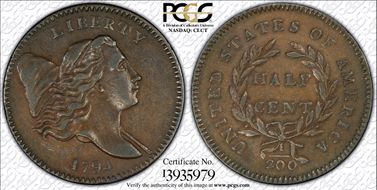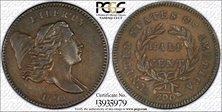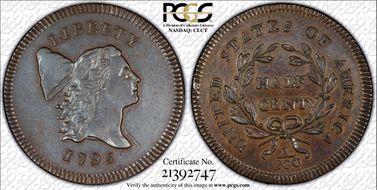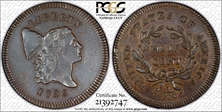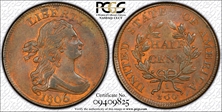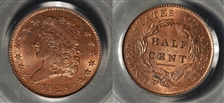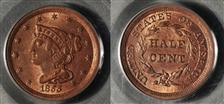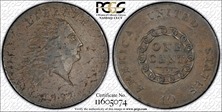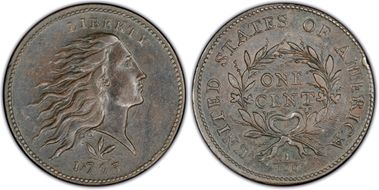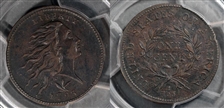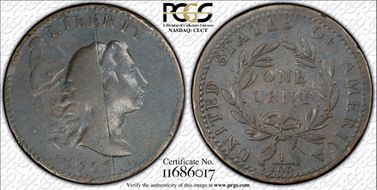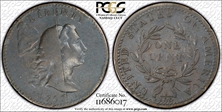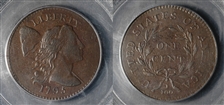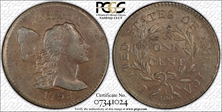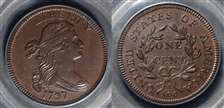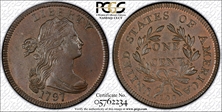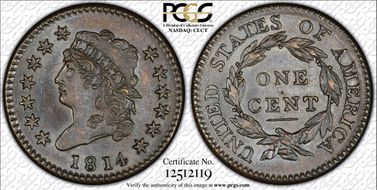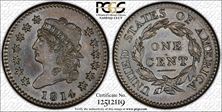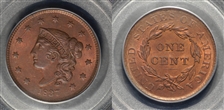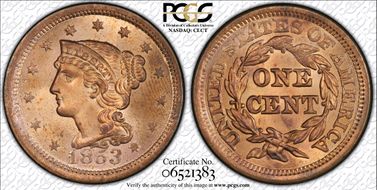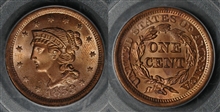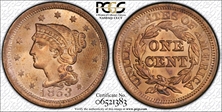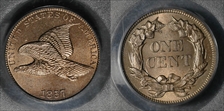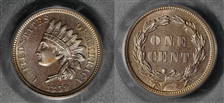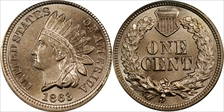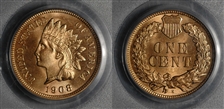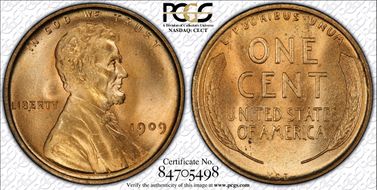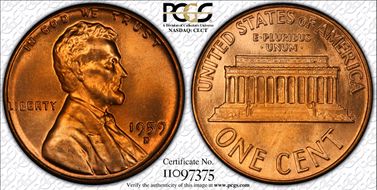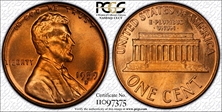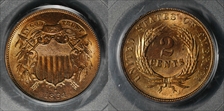Golbrecht's Raisinet Collection 的钱币相册
C-4, B-4, Low R.3. EAC 50, PQ! Manley Die State 2.0, with the die defect atop the 7. This wonderful example of this first year issue has nearly ideal color over smooth, blemish-free surfaces with well-defined, full flowing hair. It's an impressively sharp and smooth representative of this popular single-year type. Chocolate-brown dominates both sides, with a glimpse of deeper brown toning present on the lower left obverse and central reverse. Liberty's cheek and forehead display a hint of friction, but the designs are exquisitely impressed aside from minor softness on some of the letters in AMERICA. Marks are minor for the grade, and the only identifiers are two faint, superficial marks behind the cap, and two blemishes of similar small size below and between AM of AMERICA. These are inconspicuous because of subsequent natural toning, and the quality and beauty of the piece remains irrefutable. Thomas Jefferson made the half cent the lowest denomination in the 1784 “Notes on Coinage” that he submitted to the federal government. Eventually, after much delay and Congressional inaction, Jefferson's proposal emerged as the Mint Act of April 2, 1792. David Rittenhouse, Adam Eckfeldt, and Robert Birch combined to execute the design of the small copper coin with Birch and Joseph Wright engraving the dies. By May 1793 over 30,000 copper half cent planchets had been prepared and on July 20 the Philadelphia Mint coined its first 7,000 specimens. Mint employees produced a further 24,934 pieces on July 26 and the final 3,400 examples on September 18. Having delivered a total of 35,344 1793 half cents, the Mint closed on the latter date so that its staff could flee Philadelphia and its annual yellow fever epidemic.
C-2a, B-2b, High R.2. EAC 40. PQ. The Small Letters Edge subvariety. Evenly struck and undeniably attractive, this sharp golden-brown example boasts plentiful luster within the hair curls and wreath. A tiny obverse rim nick at 9 o'clock will be missed by most observers, and a minor gray spot precedes the U in UNITED.
C-2a, B-2b, High R.2. EAC 40. PQ. The Small Letters Edge subvariety. Evenly struck and undeniably attractive, this sharp golden-brown example boasts plentiful luster within the hair curls and wreath. A tiny obverse rim nick at 9 o'clock will be missed by most observers, and a minor gray spot precedes the U in UNITED.
1795 1/2 C Lettered Edge AU55 C-1, B-1, R.2. Toned a medium to dark brown in color and quite even. The strike is sharp throughout, quite an event as so many of the 1795 half cents come with poorly struck devices. Excellent surfaces are the rule, and this piece is a delight to study. There is a very faint scratch down Liberty's face below her eye, and for identification purposes a tiny planchet flake resides above the post of the E in STATES. A very scarce coin in this relatively lofty grade, with a high quality planchet and good overall eye appeal. From The Melrose Bay Collection
1795 1/2 C Lettered Edge AU55 C-1, B-1, R.2. Toned a medium to dark brown in color and quite even. The strike is sharp throughout, quite an event as so many of the 1795 half cents come with poorly struck devices. Excellent surfaces are the rule, and this piece is a delight to study. There is a very faint scratch down Liberty's face below her eye, and for identification purposes a tiny planchet flake resides above the post of the E in STATES. A very scarce coin in this relatively lofty grade, with a high quality planchet and good overall eye appeal. From The Melrose Bay Collection
1806 1/2 C Large 6, Stems MS63RB B-4, C-4, R.1. Immediately distinguishable by a large, repunched 6 with the peak affixed to the base of Liberty's bust. Much faded mint-red color remains all over the coin. Most Uncirculated representatives of this variety trace back to the hoard of 1806 B-4 Half Cents that the Chapman brothers dispersed in 1906.
1806 1/2 C Large 6, Stems MS63RB B-4, C-4, R.1. Immediately distinguishable by a large, repunched 6 with the peak affixed to the base of Liberty's bust. Much faded mint-red color remains all over the coin. Most Uncirculated representatives of this variety trace back to the hoard of 1806 B-4 Half Cents that the Chapman brothers dispersed in 1906.
1828 1/2 C 13 Stars MS64 Red. C-3, B-2, R.1. This variety is attributed by: the low 2 in the date, repunching on star 7, the second S in STATES essentially even with the tip of the highest leaf, a defect that joins the left top of H in HALF to the above leaf, and a wreath spine that extends from the leaf point above HA. Orange mint luster enlivens well preserved surfaces, and a crisp strike has emboldened the design elements. A pleasing near-Gem half cent, housed in a green-label holder. Population: 6 in 64 Red, 1 finer (2/07). EAC 63. From The Temecula Collection, Part Two.
A gorgeous fire-red near Gem type coin that has nearly mark-free surfaces. The devices are very well struck, although portions of the dentils are softly brought up. Carbon is microscopic.
1793 Chain 1C AMERICA AU53. S-3, B-4, Low R.3. EAC 40. Surfaces: The obverse surface has countless minute defects that appear to be almost entirely planchet flaws, representing an improperly refined strip of copper, a common problem in the first year of Mint operations. Sheet copper was not yet available from England, so available copper was scrap copper from local sources that Henry Voigt acquired. In his Encyclopedia of Large Cents, Breen discussed the problems with this locally available copper: "Scrap copper varied greatly in homogeneity, density, malleability, and hardness. This is partly from different trace elements and partly from the way the individual lumps had been treated in manufacture. This was a most unsatisfactory expedient; the coiner's department learned quickly that different ingots cast from it varied greatly , with far too many gas bubbles. Strip rolled from these ingots came out with too many cavities and laminations. Many surviving Chain cents accordingly show such flaws." The sophisticated collector will appreciate the planchet flaws as part of this coin's history and charm. A few tiny rim bumps are visible, and these appear to be the only post-strike imperfections. In direct opposition to the obverse, the reverse surface is nearly flawless. Only a few minute defects, rim flaws, and abrasions can be seen. Both sides have lovely medium brown color with traces of darker steel color on the high points. Considerable original mint frost remains, with splashes of lighter tan on the reverse, faded from original mint red. This example is a later die state. The obverse has prominent clash marks around and below the bust, and the reverse is flowlined with field roughening below UNITED STATES. The latest known die state of this variety, called Die State III in Breen's classification, displays heavy clash marks along Liberty's lips, chin, neck, and bust line. Breen suggested that these obverse clash marks, as seen somewhat on this example, were responsible for the "Liberty in chains epithet" sometimes given to the Chain cents. The Chain design was intended to show strength or unity of our new nation. Instead, the device was interpreted by many as representing slavery. Most of the mintage was lost or destroyed, so survivors are of various grades, usually lower quality. Porous or corroded pieces are frequently encountered. There is no question among specialists that Sheldon-3 is the most common Chain cent. Current rarity ratings for the Chain cent varieties suggest that the total surviving population of all varieties is 900 to 1,000 coins, with 400 to 500 examples of the S-3 and about 500 to 600 of all other varieties combined. Working under the assumption that the current rarity ratings are reasonably accurate, we can surmise that the original mintage occurred in about the same proportion. Approximately 18,000 examples of this die marriage were coined, with another 18,000 of the other three Sheldon numbers.
S-9, B-12, R.2. Noyes VF20; tied for CC-21. EAC VF25. PQ–. Variety: Horizontal stem parallel to the date. The bow is large and rounded. The obverse appears on S-8, S-9, and NC-4. The reverse appears on S-9. Vine and Bars Edge. The S-9 is the single most common Wreath cent variety by a wide margin. Surfaces: An attractive piece with smooth, hard, glossy surfaces. Both sides have mottled golden-brown and deep steel color. A few minor handling marks are visible on the obverse, with a small reverse edge bump over the M. Light corrosion is evident, primarily on the reverse. Full obverse and reverse borders are visible, with the reverse imperfectly centered. Both sides are sharply detailed, and the obverse and reverse types stand boldly against the field. Die State VII: The reverse has die cracks through R and CA of AMERICA, and from the left stem through UNIT. A late die state, although most of the individual die defects Breen describes are faintly visible. Census: Perhaps 10 examples are known in Mint State. This piece has considerable sharpness but is downgraded for various minor imperfections. Commentary: The S-9 is clearly the most common Wreath cent variety, and the only 1793 large cent of any design with a rarity rating less than R.3. Sheldon mentioned in Early American Cents that S.H. Chapman considered this variety to represent 35% of all existing Wreath cents. From a mintage of 63,353 Wreath cents, this would imply a "mintage" of about 22,000 coins. Raw material for copper coinage at the new Mint came from a variety of local sources, none particularly ideal, generally consisting of scrap, rough ingots, or sheet. In Breen's Large Cent Encyclopedia, contributor Craig Sholley wrote: "The locally obtained scrap proved to be especially troublesome. Copper is a difficult metal to properly melt and it is far more difficult to roll than silver or gold. The Mint, lacking both experience and proper equipment, was not prepared for either of these operations." The first of the two processes required that Mint personnel melt the metal and pour it into ingot molds, while watching for retained gas bubbles or impurities. Bubbles in the metal resulted in split planchets, laminations, or other defects to the finished coins. Impurities resulted in various streaks or discoloration spots. The other process was rolling the ingots into planchet strip of the appropriate width and thickness. The Mint used horsepower-operated rollers that were apparently poorly made. Coinage of the Wreath cents was suspended after the April 19 delivery while the rollers were repaired.
S-9, B-12, R.2. Noyes VF20; tied for CC-21. EAC VF25. PQ–. Variety: Horizontal stem parallel to the date. The bow is large and rounded. The obverse appears on S-8, S-9, and NC-4. The reverse appears on S-9. Vine and Bars Edge. The S-9 is the single most common Wreath cent variety by a wide margin. Surfaces: An attractive piece with smooth, hard, glossy surfaces. Both sides have mottled golden-brown and deep steel color. A few minor handling marks are visible on the obverse, with a small reverse edge bump over the M. Light corrosion is evident, primarily on the reverse. Full obverse and reverse borders are visible, with the reverse imperfectly centered. Both sides are sharply detailed, and the obverse and reverse types stand boldly against the field. Die State VII: The reverse has die cracks through R and CA of AMERICA, and from the left stem through UNIT. A late die state, although most of the individual die defects Breen describes are faintly visible. Census: Perhaps 10 examples are known in Mint State. This piece has considerable sharpness but is downgraded for various minor imperfections. Commentary: The S-9 is clearly the most common Wreath cent variety, and the only 1793 large cent of any design with a rarity rating less than R.3. Sheldon mentioned in Early American Cents that S.H. Chapman considered this variety to represent 35% of all existing Wreath cents. From a mintage of 63,353 Wreath cents, this would imply a "mintage" of about 22,000 coins. Raw material for copper coinage at the new Mint came from a variety of local sources, none particularly ideal, generally consisting of scrap, rough ingots, or sheet. In Breen's Large Cent Encyclopedia, contributor Craig Sholley wrote: "The locally obtained scrap proved to be especially troublesome. Copper is a difficult metal to properly melt and it is far more difficult to roll than silver or gold. The Mint, lacking both experience and proper equipment, was not prepared for either of these operations." The first of the two processes required that Mint personnel melt the metal and pour it into ingot molds, while watching for retained gas bubbles or impurities. Bubbles in the metal resulted in split planchets, laminations, or other defects to the finished coins. Impurities resulted in various streaks or discoloration spots. The other process was rolling the ingots into planchet strip of the appropriate width and thickness. The Mint used horsepower-operated rollers that were apparently poorly made. Coinage of the Wreath cents was suspended after the April 19 delivery while the rollers were repaired.
S-14 Low R.5, EAC 20. While the Chain and Wreath Cents boast the cachet of single year type status, it is the Liberty Cap design that is the scarcest for the year. Walter Breen estimated that only 250 Liberty Cap cents dated 1793 exist in all grades and of all varieties. The Sheldon-14 is an unmistakable, “naked eye” variety which can be identified at arms length by the spectacular, rim-to-rim die crack down the middle of the obverse. This is the famous Bisecting Crack variety, with a constant and readily visible (usually) vertical die crack on the obverse, from the E of LIBERTY to the 3 in the date. The crack passes through Liberty's earlobe, and almost perfectly divides the obverse in half, slightly favoring the right side. The elusiveness of this particular variety can, in large measure, be attributed to the obvious broken die, from which relatively few coins could have been struck before it finally had to be replaced. With a surviving population of about 70 pieces, the Bisecting Crack is the second most common variety of the six 1793 Liberty Caps, although it is substantially rarer than Sheldon-13. The rarity of this variety has remained essentially unchanged since 1949, when Sheldon gave it an R.5 rating. Perhaps the stable rarity rating is due to the recognizable nature of the obverse. A completed coinage die was not ready for use until it was hardened. The February 1826 issue of The Franklin Journal described the hardening process, quoted in Breen's Large Cent Encyclopedia: "The general method of hardening this metal is to heat it red hot, and then plunge it into cold water, and sometimes into mercury, in order to reduce its temperature as quickly as possible." Craig Sholley notes that the hardening process was the "moment of truth" once a die was engraved. Many dies cracked or shattered during the process. Others only hardened near the edges, and cracked or broke upon first use. It was the results of this procedure, according to Sholley, that have often been described as "poor die steel." There is little doubt that the hardening process resulted in the Bisecting Crack variety.
S-14 Low R.5, EAC 20. While the Chain and Wreath Cents boast the cachet of single year type status, it is the Liberty Cap design that is the scarcest for the year. Walter Breen estimated that only 250 Liberty Cap cents dated 1793 exist in all grades and of all varieties. The Sheldon-14 is an unmistakable, “naked eye” variety which can be identified at arms length by the spectacular, rim-to-rim die crack down the middle of the obverse. This is the famous Bisecting Crack variety, with a constant and readily visible (usually) vertical die crack on the obverse, from the E of LIBERTY to the 3 in the date. The crack passes through Liberty's earlobe, and almost perfectly divides the obverse in half, slightly favoring the right side. The elusiveness of this particular variety can, in large measure, be attributed to the obvious broken die, from which relatively few coins could have been struck before it finally had to be replaced. With a surviving population of about 70 pieces, the Bisecting Crack is the second most common variety of the six 1793 Liberty Caps, although it is substantially rarer than Sheldon-13. The rarity of this variety has remained essentially unchanged since 1949, when Sheldon gave it an R.5 rating. Perhaps the stable rarity rating is due to the recognizable nature of the obverse. A completed coinage die was not ready for use until it was hardened. The February 1826 issue of The Franklin Journal described the hardening process, quoted in Breen's Large Cent Encyclopedia: "The general method of hardening this metal is to heat it red hot, and then plunge it into cold water, and sometimes into mercury, in order to reduce its temperature as quickly as possible." Craig Sholley notes that the hardening process was the "moment of truth" once a die was engraved. Many dies cracked or shattered during the process. Others only hardened near the edges, and cracked or broke upon first use. It was the results of this procedure, according to Sholley, that have often been described as "poor die steel." There is little doubt that the hardening process resulted in the Bisecting Crack variety.
1795 1C Plain Edge AU58 S-78, B-8, R.1. This is one of the most common of all Liberty Cap large cent varieties and an ideal candidate for the date or type collector. For this die pairing, the peak of the 5 in the date just touches the bust truncation. Date and LIBERTY are closely spaced. ONE CENT is centered in the wreath and widely separated. ONE CENT is high in the wreath, as the engraver avoided placing CENT within the narrow space between the lower leaves, and the E in STATES is entered high. Specialists of 1795 cents know that the two most common varieties are S-76b and S-78, both Plain Edge varieties. The Lettered Edge varieties are significantly scarcer, as indicated by Guide Book prices. While none of the three collectible Plain Edge 1795 cent die pairs can be considered more than scarce, the type is more in-demand than the supply can handle, especially for better conditions such as Choice AU.
1795 1C Plain Edge AU58 S-78, B-8, R.1. This is one of the most common of all Liberty Cap large cent varieties and an ideal candidate for the date or type collector. For this die pairing, the peak of the 5 in the date just touches the bust truncation. Date and LIBERTY are closely spaced. ONE CENT is centered in the wreath and widely separated. ONE CENT is high in the wreath, as the engraver avoided placing CENT within the narrow space between the lower leaves, and the E in STATES is entered high. Specialists of 1795 cents know that the two most common varieties are S-76b and S-78, both Plain Edge varieties. The Lettered Edge varieties are significantly scarcer, as indicated by Guide Book prices. While none of the three collectible Plain Edge 1795 cent die pairs can be considered more than scarce, the type is more in-demand than the supply can handle, especially for better conditions such as Choice AU.
1795 1C Plain Edge AU58 S-78, B-8, R.1. This is one of the most common of all Liberty Cap large cent varieties and an ideal candidate for the date or type collector. For this die pairing, the peak of the 5 in the date just touches the bust truncation. Date and LIBERTY are closely spaced. ONE CENT is centered in the wreath and widely separated. ONE CENT is high in the wreath, as the engraver avoided placing CENT within the narrow space between the lower leaves, and the E in STATES is entered high. Specialists of 1795 cents know that the two most common varieties are S-76b and S-78, both Plain Edge varieties. The Lettered Edge varieties are significantly scarcer, as indicated by Guide Book prices. While none of the three collectible Plain Edge 1795 cent die pairs can be considered more than scarce, the type is more in-demand than the supply can handle, especially for better conditions such as Choice AU.
1797 1C Reverse of 1797, Stems, S-123, B-12, R.4 MS64BN. This coin probably traces its origin back to the Nichols find, which included many Mint State examples of this scarce variety. Sheldon-123 is one of three varieties (the other two are S-119 and S-135) made collectible in Uncirculated grades due to the Nichols Find. However, a glance at third party populations confirms that quality examples are rare by the standards of most U.S. series. This is the second of the three varieties attributed to the Nichols Find, with an extremely close date, six berries in each branch, and the final 0 high. The obverse appears on S-122, S-123, NC-2, and NC-3. The reverse appears on 1796 S-119 and 1797 S-123. There is a tiny cut (die chip) on Liberty's cheek below the eye--a diagnostic feature of this S-123--which identifies this Nichols Find variety, which is usually found in or near Mint State grades. At least 10 examples of this variety are known in Mint State, and many more just miss that level, usually with full Mint State sharpness and minor deductions for slight imperfections. Considered R.4, meaning between 80 and 200 examples survive, well over half of the known examples grade AU or better. In fact, the variety would probably be a solid R.5 or perhaps even R.6 if that hoard never existed. Like nearly all coins from the Nichols Find, the surfaces of both sides are a pleasing medium brown with slightly reflective fields. This exceptionally well struck, orange-brown example has unusually smooth surfaces and excellent eye appeal.
1797 1C Reverse of 1797, Stems, S-123, B-12, R.4 MS64BN. This coin probably traces its origin back to the Nichols find, which included many Mint State examples of this scarce variety. Sheldon-123 is one of three varieties (the other two are S-119 and S-135) made collectible in Uncirculated grades due to the Nichols Find. However, a glance at third party populations confirms that quality examples are rare by the standards of most U.S. series. This is the second of the three varieties attributed to the Nichols Find, with an extremely close date, six berries in each branch, and the final 0 high. The obverse appears on S-122, S-123, NC-2, and NC-3. The reverse appears on 1796 S-119 and 1797 S-123. There is a tiny cut (die chip) on Liberty's cheek below the eye--a diagnostic feature of this S-123--which identifies this Nichols Find variety, which is usually found in or near Mint State grades. At least 10 examples of this variety are known in Mint State, and many more just miss that level, usually with full Mint State sharpness and minor deductions for slight imperfections. Considered R.4, meaning between 80 and 200 examples survive, well over half of the known examples grade AU or better. In fact, the variety would probably be a solid R.5 or perhaps even R.6 if that hoard never existed. Like nearly all coins from the Nichols Find, the surfaces of both sides are a pleasing medium brown with slightly reflective fields. This exceptionally well struck, orange-brown example has unusually smooth surfaces and excellent eye appeal.
1797 1C Reverse of 1797, Stems, S-123, B-12, R.4 MS64BN. This coin probably traces its origin back to the Nichols find, which included many Mint State examples of this scarce variety. Sheldon-123 is one of three varieties (the other two are S-119 and S-135) made collectible in Uncirculated grades due to the Nichols Find. However, a glance at third party populations confirms that quality examples are rare by the standards of most U.S. series. This is the second of the three varieties attributed to the Nichols Find, with an extremely close date, six berries in each branch, and the final 0 high. The obverse appears on S-122, S-123, NC-2, and NC-3. The reverse appears on 1796 S-119 and 1797 S-123. There is a tiny cut (die chip) on Liberty's cheek below the eye--a diagnostic feature of this S-123--which identifies this Nichols Find variety, which is usually found in or near Mint State grades. At least 10 examples of this variety are known in Mint State, and many more just miss that level, usually with full Mint State sharpness and minor deductions for slight imperfections. Considered R.4, meaning between 80 and 200 examples survive, well over half of the known examples grade AU or better. In fact, the variety would probably be a solid R.5 or perhaps even R.6 if that hoard never existed. Like nearly all coins from the Nichols Find, the surfaces of both sides are a pleasing medium brown with slightly reflective fields. This exceptionally well struck, orange-brown example has unusually smooth surfaces and excellent eye appeal.
1814 1C Crosslet 4 MS63BN S-294, B-1, R.1. Only two die marriages are known for 1814 Cents, and each receives a separate Guide Book listing due to a different logotype on the 4. Traces of faded red color surround the legends and stars, while the fields and portrait exhibit steel-brown color. This well struck Large Cent has a nearly undisturbed obverse, and the reverse is also refreshingly clean. This is a relatively common Classic cent, but always of great importance to type collectors, as these pieces become scarce in XF and better grades.
1814 1C Crosslet 4 MS63BN S-294, B-1, R.1. Only two die marriages are known for 1814 Cents, and each receives a separate Guide Book listing due to a different logotype on the 4. Traces of faded red color surround the legends and stars, while the fields and portrait exhibit steel-brown color. This well struck Large Cent has a nearly undisturbed obverse, and the reverse is also refreshingly clean. This is a relatively common Classic cent, but always of great importance to type collectors, as these pieces become scarce in XF and better grades.
1837 1C Medium Letters MS65RB. N-6, Low R.2. The 3 in the date is low, and the left foot of the N in ONE is recut. An interesting example from a year in which the cent was the only copper denomination coined, this Gem cent has considerable original orange mint color.
1853 MS65RD. So firey red the coin almost looks like it was minted yesterday, with virtually no marks and only a slight partial fingerprint to justify this grade, as opposed to a higher one.
1853 MS65RD. So firey red the coin almost looks like it was minted yesterday, with virtually no marks and only a slight partial fingerprint to justify this grade, as opposed to a higher one.
1853 MS65RD. So firey red the coin almost looks like it was minted yesterday, with virtually no marks and only a slight partial fingerprint to justify this grade, as opposed to a higher one.
1857 Flying Eagle Cent, graded MS-65. Simply outstanding! This coin has a full strike and breathtaking eye appeal. It is a gem in every respect. The color is an even light nickel color with just a light contact marks above the Eagle's left wing. The reverse is nearly mark free. A superb coin. Pop 166; 15 finer in 66. Ex:The "Chiro" Collection. Eagle Eye Photo Seal.
1859 1C MS65. This is the first year of issue for the Indian Cent design by James Barton Longacre, and it is a one-year design type. The characteristic striking weaknesses which the Mint experienced during production of the Flying Eagle Cent prompted Mint Director Colonel James Ross Snowden to order designer/engraver James Longacre to prepare other cent designs, one of which would replace the Flying Eagle as of January 1, 1859. After reviewing various pattern cents, Snowden chose the Indian/laurel wreath combination because it was in lowest relief of all the candidates, striking up better than the others. This coin became the Indian Cent, which has been immensely popular with generations of collectors. With the Indian cent design as adopted on cents from 1860 through 1909 on the obverse, and the laurel wreath reverse that was only used in this year, the 1859 has proved to be a type coin of enduring popularity. Unfortunately for the Mint as well as modern collectors, this issue proved equally difficult to strike as its Flying Eagle predecessors. Many otherwise attractive coins are limited in grade by bluntness of detail over the date, denomination, feather tips, and diamonds. Not so the present Gem. Every feature is well brought up, and the smooth surfaces are devoid of any major distractions. This example is fully lustrous and sharply struck with exquisite golden-tan coloration.The premier delivery in 1859 totaled 36.4 million pieces, and they are distinct as being the only coins in this series with a laurel wreath enclosing the denomination ONE CENT on the reverse. The obverse has a profile of Liberty facing to the left, wearing a headdress consisting of nine broad feathers. The band on the headdress is inscribed with the word LIBERTY, and a ribbon hangs down near the neck, containing four decorative diamonds. A small raised die chip on Liberty's cheek identifies this obverse die. The reverse consists of a laurel wreath, open at the top, and tied by a ribbon at the bottom. This wreath encloses the denomination ONE CENT. The reverse die is well-made without any die defects.
Khaki-olive color cascades across both sides of this satiny Gem. Conditionally rare and ranked as one of the finest-known representatives of the date, one is unable to locate even the the most paltry of abrasions on this coin. Eagle Eye Photo Seal approved, with card of authenticity.
1908-S 1C MS66RD. This is an outstanding, intensely bright example of the first minor (copper) coinage issue struck at a branch mint in the United States. Judging from the population data, the 1908-S and 1909-S Indian cents are about equal in rarity in high grades with full red color, and both are much, much rarer than the 1909-S VDB cent in such condition. Although the 1908-S was probably saved to some degree as the first mintmarked cent, the 1909-S Indian was saved as the last of the series (and the general collecting public saved many more 'SVDBs as a novel new design). The San Francisco cents of 1908 and 1909 were struck on lighter-colored planchets than earlier cent issues. The '08-S is a scarce (1.1 million pieces produced), semi-key issue in the Indian Head cent series at all levels of preservation. Obviously set aside shortly after delivery, this fully Red, carbon-free example of this introductory, branch-mint Indian cent displays unbelievable flash. The coin possesses full mint luster and even, orange-red coloration. Copper-gold luster adorns both sides, and the well-executed, virtually full strike is exacting throughout, resulting in crisp definition of the design features, including sharpness on the bowknot, all four diamonds, and on the tips of the feathers at the top of the Indian's headdress. Both sides are exceptionally smooth with a shimmering satin texture. Close examination reveals remarkably clean surfaces and no spots worthy of note; There are only a couple of slight, relatively unobtrusive contact marks on the cheek and neck to justify this grade, as opposed to a higher one. A magnificent example of this scarce, late-date Indian cent, this piece shows even, bright mint red color, unlike the streaky coins often seen on 1908 and especially 1909 cents. Rick Snow states "Full feathers are extremely rare" [on an '08-S] but if the strike atop the headdress feathers of this coin is not fully razor-sharp, in light of the issue's striking weakness being ever-present, this is forgivable. The Eliasberg catalog notes that 1908-S cents were struck on silver presses. The hardness of bronze compared to silver might help explain why this issue is usually found softly struck. That being said, Mr. Eliasberg held out for a sharp one, and I've been fortunate, too. The srike on this piece is exemplary. It would be difficult to imagine a more attractive example.
1959-D 1C MS66RD. Mintage: 1,279,760,000. A nearly immaculate Premium Gem, with exceptional quality for this first-year Memorial reverse issue. Brilliant, fiery mint-red color and stunning luster radiates from surfaces that reveal no mentionable spots or abrasions. The design elements are adequately struck.
1959-D 1C MS66RD. Mintage: 1,279,760,000. A nearly immaculate Premium Gem, with exceptional quality for this first-year Memorial reverse issue. Brilliant, fiery mint-red color and stunning luster radiates from surfaces that reveal no mentionable spots or abrasions. The design elements are adequately struck.
1864 2C Large Motto MS65RD. A fiery, very premium quality Gem of this important and widely collected odd denomination. Millions were struck of this first year issue, but full red Gems are anything but common. The surfaces of this coin display a vibrant and totally original orange-red color that barely shows just a whisper mellowing in the nearly 15 decades since its Civil War era origin. The mint red color is virtually undiminished by the passage of time, appearing today much as it did in 1864, the year Colonel Chivington massacred the Southern Cheyenne at Sand Creek. This unusual denomination was created to help fill the yawning gap in circulating coinage that resulted from the widespread hoarding of coins in the early 1860s. An historic issue designed by James Barton Longacre that is indelibly linked with the Civil War, the 1864 two cent piece is also the first U.S. coin to bear the motto IN GOD WE TRUST. The present example is the second and more commorn of the two varieties produced this year. The earlier Small Motto coins were prototypes and modified after only a few thousand were struck, with the motto enlarged on subsequent strikings. Far fewer of the Small Motto coins are seen today with full red color than of their Large Motto counterparts. Held back from an even higher grade only by light, scattered flyspecks, and uncommonly attractive even for the MS65 grade, this Large Motto Gem shows nearly full mint-red color. Both sides are intensely lustrous, with vivid crimson-orange color. All features show pinpoint striking definition, with with good detail to the highpoints. The lustrous and unabraded surfaces have no obtrusive contact marks, and only negligible carbon.




















